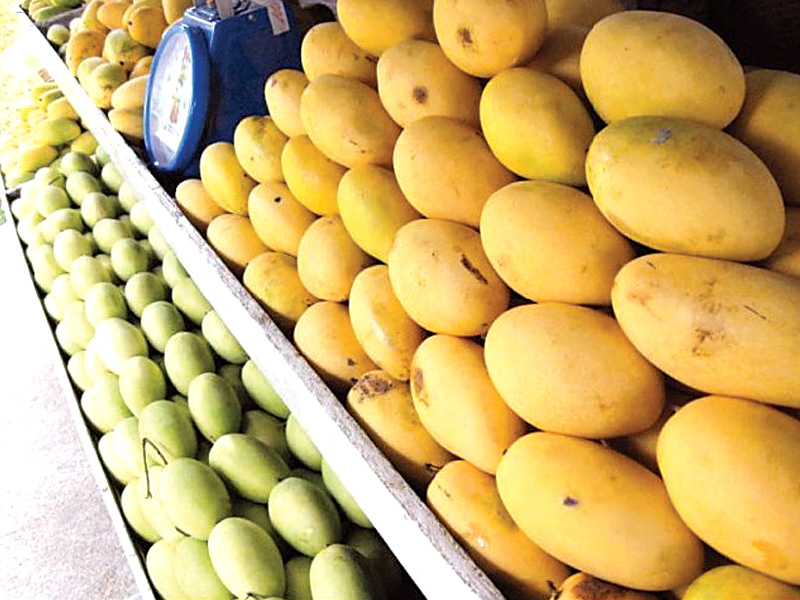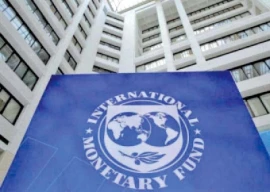
Chairman, All Pakistan Fruit and Vegetable Exporters, Importers and Merchants Association (PFVA), Waheed Ahmed, said that Pakistani mango was unable to reach the US market because of a mandatory requirement for treatment of mangoes through an approved irradiation center– a modern food preservation technology that can extend the shelf-life of food.

“Unfortunately, despite the successful introduction of our fruit in the US market four years ago, we could not commercially start the business, thus providing room to other mango exporting countries especially India,” said Ahmed.
India has set up an irradiation center at Maharashtra, and a similar facility at Karachi could be very helpful for Pakistani exports, he said.
Fruit exporters fear that once the lucrative market is fully tapped by Indian exporters, Pakistanis will face difficulty in finding ground in the US, which has highly quality conscious consumers.
On the other hand India, with the help of the modern irradiation facility, has exported a record 500 metric tonnes (MT) of mangoes to the US this year. India – the world’s largest grower of mangoes, started exports to the US in 2007 after attaining an irradiation facility to get rid of fruit flies and other diseases.
With the absence of an irradiation facility in Pakistan, the governments of Pakistan and US discussed various alternate options to start commercial exports to US, but were unsuccessful.
In 2010, two viable options were discussed including the establishment of a pre-clearance program from National Plant Protection Organization/MINFA, along with an Operational Work Plan for commodities shipped through pre-clearance to meet Phytosanitary entry requirements. The consignments would have been treated in US for mitigation of mango pest risks pending approval of pre-clearance program. This would have been quicker.
It was also agreed in principle that initially, mango producers certified by Global Gap with experience in produce export markets will be considered under this program. None of the options were implemented.
Treating Pakistani mangoes in the US was not feasible because of high transportation costs, as the fruit needed to be sent to Chicago for treatment before sending them to various other cities.
Though Pakistan International Airline (PIA) has been requested several times in various meetings held during the last couple of years, the national carrier has failed to arrange direct flights from Pakistan to Chicago.
Rise in exports
According to Ahmed, the good news is that the mango exports this year has reached a historic mark of 163,000MT, worth $55.74 million so far as compared to the total export of 118,000MT worth $38 million recorded last year.
With 30 days of exports remaining, the mark this year is expected to reach at around 190,000MT, crossing the target of 175,000MT set for this season. However, any further rise in exports is directly linked with the quality of the fruit and weather conditions.
Interestingly, the increase in the demand for mango in Muslim countries during the holy month of Ramadan had remarkably supported this business. Almost 80% of the fruit was exported to the Muslim countries.
Pakistani mangoes have successfully been introduced in Japan and Australia.
Published in The Express Tribune, September 4th, 2013.
Like Business on Facebook, follow @TribuneBiz on Twitter to stay informed and join in the conversation.
COMMENTS (20)
Comments are moderated and generally will be posted if they are on-topic and not abusive.
For more information, please see our Comments FAQ

1732437695-0/drake-and-charles-(1)1732437695-0-165x106.webp)


1732434981-0/BeFunky-collage-(10)1732434981-0-165x106.webp)












@Saleem:
"the cost to build a food irradiation plant is in the range of $1 million to $3 million, depending on size, "
There is no way to build an irradiation facility for $1 M to $3M to treat hundreds of thousands of mangoes in the very short harvesting period.
According to Iowa State University Food and Health program the cost to build a food irradiation plant is in the range of $1 million to $3 million, depending on size, processing capacity, and other factors. It is pathetic that export of Pakistani mangoes is held up for few million dollars
Here's a thought. Stop the imports and increase supply in domestic market so prices go down for local consumers. Replace the lost foreign exchange with some competent economic policies & governance such as fixing power outages which are hitting textile industries or stopping the depreciation of currency which is making imports (like oil) expensive or introducing a mass transit system/ launching coal burning plants to reduce dependence on oil imports and so on & so on...but keep the mangoes at home. I say this as a sincere expat.
@Sandip: Pakistani mangoes likely cannot compete with India's own production. India exports mangoes because it has more than it needs. Why would it then import from Pakistan?
@Dipak: Ditto. I felt the same when I was buying mangoes in New York or Atlanta. Indian families are getting used to the taste of Kent mangoes and the boxes move very fast. Patel Brothers has to keep replenishing supplies. In comparison, the few boxes of Sindhuri or Alphonso keep sitting on the shelves. They are way too expensive.
@leela
LOL! Two thumbs up.
Just two weeks ago, I wrote a comment in Times of India about Indian mangoes sold in USA. Generally India exports Alphonso and Kesar varieties to USA. I heard Kesar is known as Sindhri or some thing similar in Pakistan. Unfortunately, I foresee no future for either Indian or Pakistani mangoes in USA. The reason is simple. The Kent mangoes grown in Florida and Mexico have taken over the market in USA. The fruit is larger, sweeter with lots of tasty pulp. This variety is heavy in weight about 500 gm. to 1 Kg. The Indian and Pakistani mangoes weigh from 200 to 300 grams each. Now the real surprise. A box of 12 Pakistani and Indian mangoes weighing about 3 Kg. is sold for $36.00. That is $12.00 per Kg. The Kent mangoes are sold in 6 to 12 mangoes per box weighing 5 Kg. at a price of $9.00 per box. That is $1.80 per Kg. When taste of all mangoes is about the same who will care of Pakistani or Indian mangoes. You be the judge. I got lots of negative comments in TOI and will get them from Tribune. But the fact is fact. Don't waste time and money for irradiation facilities, instead do business with neighboring countries. Sorry, but Pakistani and Indian mangoes have no future in USA.
Why not send the mangoes for irradiation to Montreal and from there to NorthEastern USA, from Chicago to Central/Northern USA and through Mexico to Western USA. wouldnt that provide feasibility
@Observer: Here is another thought. Just as @Modified has stated, why go through all the hassle of sending to Mumbai only to reexport to US? Why not just export to India? This has been Pakistan's problem throughout. It has gone seeking markets in US, Europe, China and other places halfway around the globe. But it is too ghairatmand to trade with India. I hope Pakistanis wake up to the utter idiocy of this mindset.
Maybe they remember the case of the exploding mango!
No direct flights between Pakistan and USA have been allowed due to security concerns! This is the result of the observance of "connected" individuals regularly using PIA "Protocol Officers" to bypass all security checkpoints to board planes in Pakistani airports!
@Unkown:
"The maxican mangoes that we have in US are tasteless in comparison with the mangoes of multan. I wish that Pakistan should send chonsa, anwar atol, and langra Aam to US and we should enjoy them here as well."
The Mexican have managed to get many of the Indian mango seeds. Some varieties such as Kent are very good and resemble, though not fully, the taste of Indian mangoes.
The Indian grocery stores do sell imported Indian mangoes when in season.
Though Pakistan International Airline (PIA) has been requested several times in various meetings held during the last couple of years, the national carrier has failed to arrange direct flights from Pakistan to Chicago.
PIA is cautious as Pakistani mango crates in the past have been known to behave funnily at high altitudes!
There is only one type of mango exist in the world and that is Pakistani mango. It is US loss.
The maxican mangoes that we have in US are tasteless in comparison with the mangoes of multan. I wish that Pakistan should send chonsa, anwar atol, and langra Aam to US and we should enjoy them here as well.
Here is a thought. Why not use the Indian facility on a fee basis to irradiate the mangoes and export them from Mubai directly? I assume the Indian facility has the capacity to treat Pakistani mangoes in addition to the Indian ones.
Some of the info is incorrect. There IS an irraditation facility on Multan Road somewhere close to where one gets on M2 motorway at Thokar Niaz Beg (on the left side when coming from Thokar Niaz Beg). It was used for irradiation of surgical equipment and they were talking about irradiation of fruit (about 10-12 years ago). Its run by the PAEC. But that being said, they will sit quietly, draining government coffers for salaries and not get business such as this. Why work when you can get salary doing nothing?
I know all this as my father retired from the PAEC more than a decade ago and I remember him visiting this facility and talking with the people there about irradiation of fruit and its potential for opening up fruit markets abroad!
we beggars have failed to take advantage even after other countries have lowered their standards for us.. what a shame for us..
Why bother sending to USA. Pakistani mangoes are already selling well in India http://economictimes.indiatimes.com/news/economy/agriculture/pakistan-mangoes-sell-at-rs-80/kg-in-delhi-as-against-rs-150-200-for-desi-variety/articleshow/22239962.cms
export more and more to India. Entire harvest can be consumed by few Indian cities.
Mangoes have lately become very popular in US and is showing up as an ingredient in food items such as Mango Salsa, Mango shortbread, Mango Tilapia (fish) and a bunch of Mango themed sauces and curries etc. Mango is being promoted as the new health food and is believed to be a negative calorie food, though I think it is marketing as it has too much sugar to be negative calorie. Anyway, it is high time that Pakistani officials take advantage of this recently found popularity of mangoes in US and get hold of an irradiation plant. An irradiation plant is not too expensive and one can be set up in Pakistan at a cost of 35 crore rupees ($3 million) or so.There is also a decent sized Pakistani and Indian population that would love to have access to Pakistani mangoes for general consumption.